
How Believing In Yourself Can Be Your Super Power: Andrea Ehret
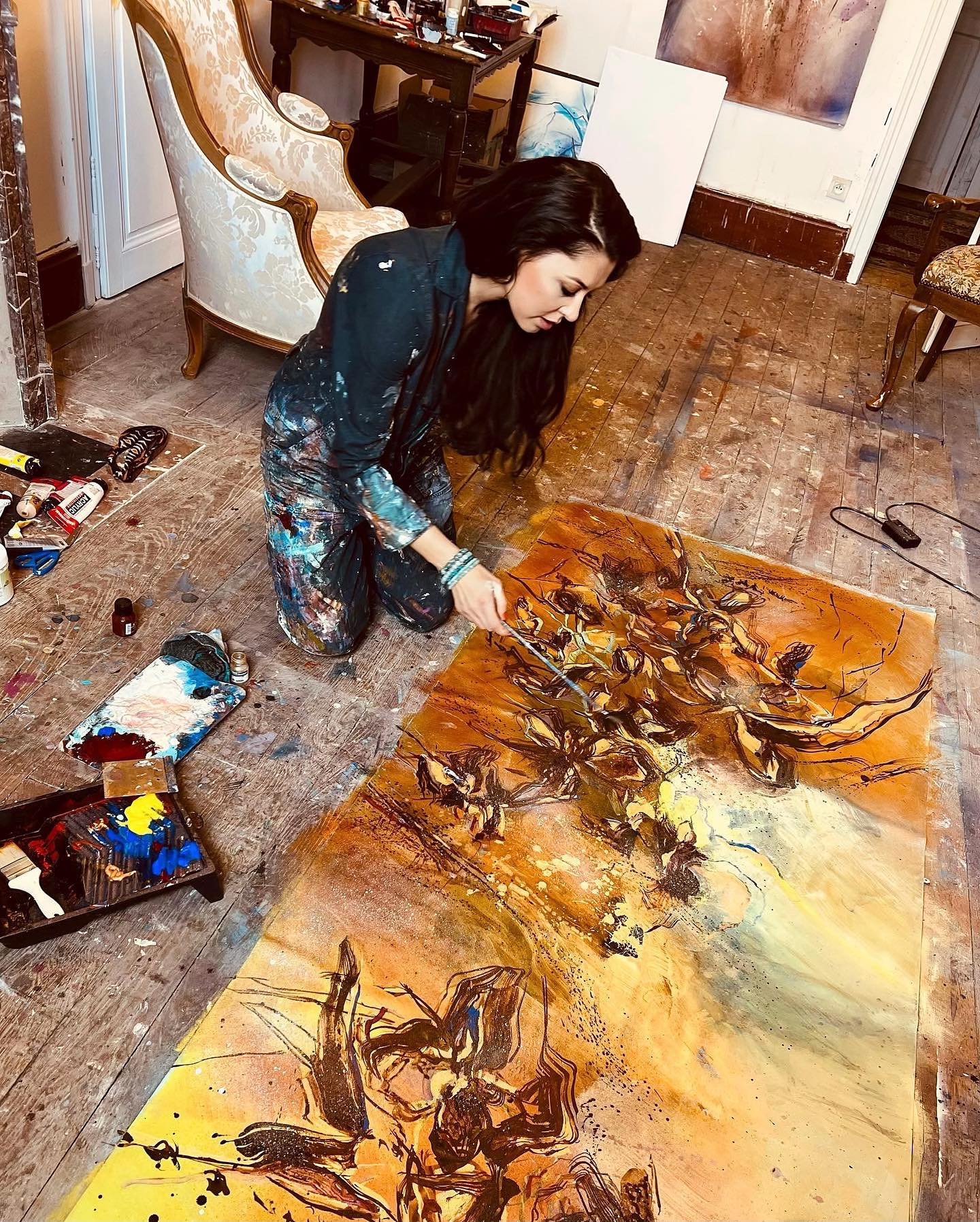

In this episode of Arts to Hearts Podcast, Charuka Arora and Andrea Ehret, an artist and art therapist, take us on a journey exploring the world of art and creativity. They discuss the importance of creative expression and believing in yourself as an artist through their conversation. They also talked about education, how to pursue an artist career, and finding authenticity in art. They also discuss the ever-evolving art world and the challenges of adapting to the changing times.
Additionally, they delve into the creative process, navigating family life, pursuing artistic dreams, and raising creative children.
Finally, Andrea reflects on the creative struggle and shares her creative projects and charitable work, giving us a glimpse into the life of an artist and their creative journey.
This conversation will give listeners an appreciation for the creative process and a deeper understanding of creativity and how it can be a source of joy and connection.
Topics covered in this podcast
- 00:00: Andrea, on the Moment of Realizing their Passion for Art
- 14:19: Conversation on Finding Authenticity in Art
- 19:48: Conversation between Charuka Arora and Andrea on Evolving with Changing Times
- 21:36: Conversation with Artist Andrea on Finding Authenticity and Voice in Abstract Art
- 36:28: Conversation on Pursuing a Career Despite Challenges
- 38:17: Conversation between Charuka Arora and Andrea on Raising Creative Children
- 42:33: Advice on Balancing Artistic Aspirations and Personal Life
- 45:08: Reflections on the Creative Struggle
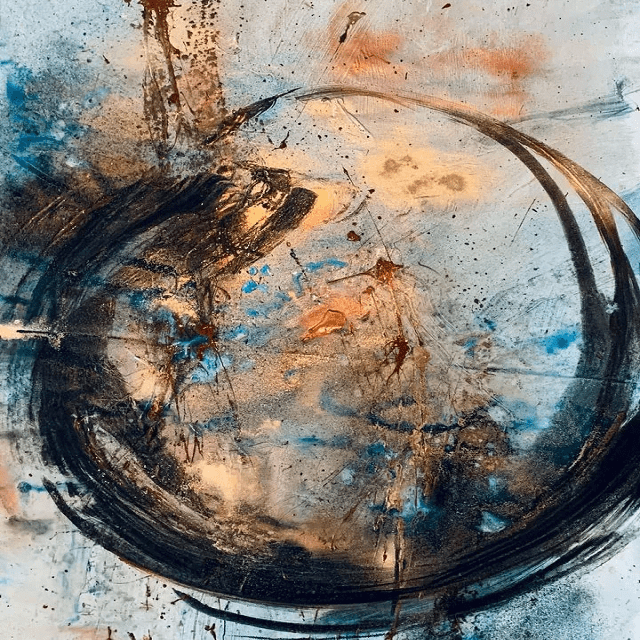


About Andrea Ehret
Slovak artist, art therapist, and performer in Prague, Czech Republic. My artwork is mainly concentrated on abstract expressive oil and mixed media painting. I lead regular international art therapy and painting workshops for children & adults. My approach is strongly connected to my vision of life; I choose life as a tool for self-transformation. I firmly believe art can heal and awaken. My artworks are part of private collections all around the world. I exhibited my art internationally: e.g., in the Czech Republic, Slovakia, Germany, the UK, the USA, the Netherlands, etc.
Looking for a connection between the visible and invisible world. I wish to portray brimming and fierce life. I throw myself out there.
My playful and authentic technique transports my audience through a dream-like experience. While my perceptions and emotions inspire my art pieces, they remain open to the viewer’s interpretation based on their reflection while immersed in a world away from reality.
In my abstract expressive artworks, I often use impasto layers, acrylic, oil, and metal gold or silver pigments on canvas or paper. Exploring the spontaneity of liquid media sometimes makes the process more playful and intuitive. In my latest series, I concentrate on the beauty of life, mother Earth, botanical motives, and dreams…combined with the inspiration of great poets: Neruda, Rilke, Verlaine, and others.
There is a sense of longing, passion, engaging movement, and contrasting boundaries of light and darkness, sunshine and clouds. I do not worry about where my works stand in relation to other artists or art movements.

Watch & Listen to this podcast Episode
Key Highlights from the Episode
Q. Charuka: Tell me something. Let’s start with: When did you first think you wanted to be an artist? We all uncover that at some point in our lives. What was that moment like for you?
A. Andrea Ehret: I think that everything you ask is probably connected to my childhood and my childhood memories. Because I remember having a father who was showing me the unusual shapes, or, you know, teaching me a conscious observation, which led me to realize what amazing things, shapes, or colors life can offer, and I was one of these children who was constantly amazed.
You know, I was amazed by the color. who was constantly amazed by practically anything in life? What was visual was what was coming my way from nature, and so it probably created the moments when I came to.at my teenage age, I decided—or I was always, you know, creating something to draw in something.
My mom was an artist. My father was an architect; my mother is an art teacher who draws in paint; and my father worked as an architect who was working with boot, and he always does so, he created like a wooden sculptures, or he was having that type of observation of shapes, which led me to understand the life better.
I think sincerely, so, I’m very thankful for my parents. They guided me that way towards my realisation.
This is what I want to do: I want to express myself, and I want to express myself in colour.
So early in my teenager part of my life, everyone is like discovering or rediscovering who they are. I created a lot, I drew a lot, and I painted a lot. You know, I was part of numerous small competitions, like a children’s or student’s competition, and then I decided I would like to go and pursue an artist’s career. So I studied art, and I’m not sure where I was, but I know I was in Slovakia, where I was born. It’s a small country in Europe, in central Europe, close to the Czech Republic, and I’m from Slovakia, so I studied at Princeton in the faculty of arts and humanities. And then, I don’t know exactly when that came,
but I was always fascinated by the world of the arts and, you know, the artist’s life and biographies and all these things; they were just always connected to my life.
So I don’t. I can’t exactly point the finger, you know, like there was a moment when I was an artist, but I always kind of felt that art was part of my life. Always.

Q. Charuka: But tell me something about how you just said, like, you know, and this is something I’m sure a lot of people who are just finding their ways and figuring things out would come up with when we say, like, you know,Authentic. It’s a word that you know we use so often, and I’m interested in knowing how you found your authenticity, like, Okay, I did this, and I felt like, This is what I believe is me. This is me as a creative person.
How did you figure out that what I’m making right now feels real to me? This is not under any influence, and you are getting closer to who you are.
A. Andrea Ehret: I think you just, you know, somehow feel it in your guts and whenever you copy something. You also feel it. You know you can get inspired by others, and you know it’s absolutely inevitable that you will be inspired because of that visual, you know, of things being overcome. It’s on social media, in the art world, at exhibitions, or in the studios of other artists. It’s. Of course, it’s inevitable. It’s going to happen. You’re going to be inspired by either the world or other artists.
But in the moment when you know that the way you create is coming from you, you are in the flow of creating. You can get inspired, but you implement that. Part of inspiration is finding your own voice. You feel it. You feel that this is something that is yours.
I think that, whether you want to admit it or not, you always feel whether it’s authentic. You know, you feel it in your heart and in your gut. You know that you feel that you are so connected to yourself while you create that nothing from the outside world can actually achieve that connection with you at that moment.
Sometimes it’s even disturbing, so people will call you to eat or drink, and you know that you don’t want to because you are in the middle of something. So I think that is important, but I also think what is important, very important, is what I am telling my students when they ask similar questions.
Don’t seek outside validation. You know, seek your own validation of what you do and when you can look at your own work and say, Oh my God, really, this is me. You know, I connect with it so much that I see myself.
And it speaks to others. You also would see how that speaks to others if it pursues them through the channel like something that’s coming across like a tent. If it doesn’t, then usually, you know, it doesn’t make an impact the way when it’s real and I think. I think you know that a good painting is always a good painting. It’s abstract painting What is vigorative painting whether it’s whatever it taste you know, but it’s good painting and if it’s not then it doesn’t speak and if it’s copy.It doesn’t speak.
so you know I mean the most important of all is that when you don’t seek the outside validation, you find it in yourself and see it in the way you pursue the creative process? But also, what is it? What is it bringing back to you? What do you see in it, and how do you think this speaks to others? Okay, so that’s the thing. The first level of it.
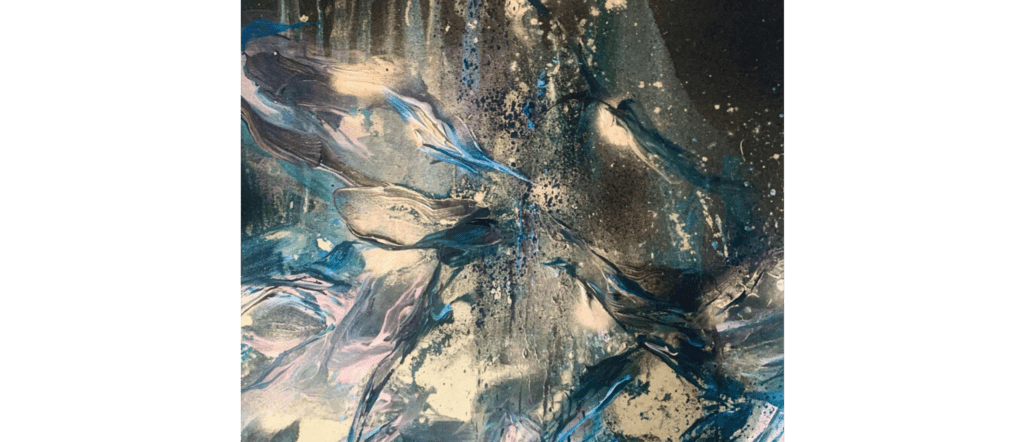
Q. Charuka: While you’re speaking of this. What do you think was your biggest struggle when it came to finding that authenticity? Like, what was the hardest part of it?
A. Andrea Ehret: All the hardest parts were probably getting rid of all the academic knowledge. Like you are so much invested in it and in that World. You speak to people you admire, or you are guided or influenced by great people, right? You do the work under their supervision, and then Ah, you have so much trouble getting rid of it because, as you say, you know their voice is so strong and already authentic that it’s in you, and you have to get rid of all that.
So when I started to paint in my studios, I was actually feeling that there was a lot of influence from university professors and other people I admire as artist. And I was working through my process of finding Really, what I wanted to say through my art faded, and then I just stayed by myself, and that was the end of it.
That’s when I realised what it was. And it took me a while, I believe years, to get rid of it because, you know, I cou;d actually felt it in my work. There was an imprint of them, even though I didn’t want that. You know, but it did—their voices were so strong that they stayed with me for a while, and then, you know, I just had to take what they said and somehow make it mine, but in a different way.
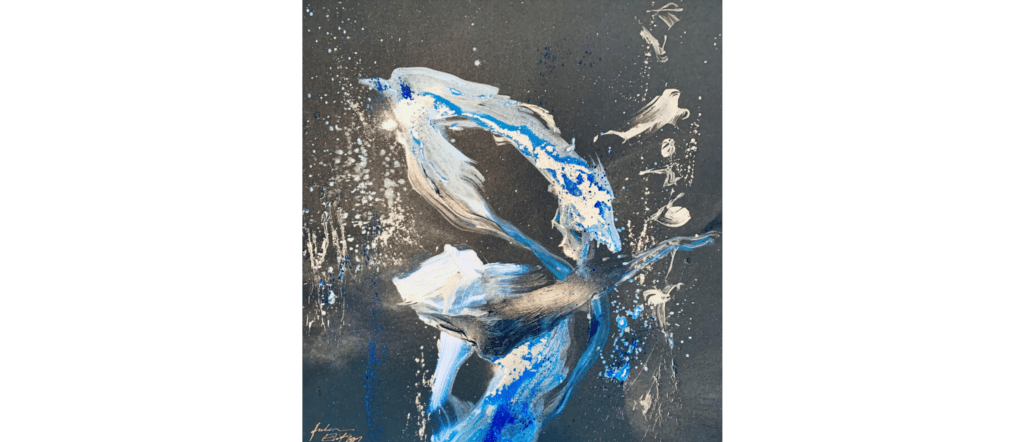
Q. Charuka: Love that. Okay, here’s something I really want to ask. This is very personal to me; we were just speaking about, um, you know. Authenticity and finding your voice are two things I’ve talked about, even in the previous recording today. I don’t make abstract art, and I’m very interested in knowing how the mind of an abstract artist works. You know about figurative. You know, like your paintings say something on their own?
But when you are making that art, do you already have an idea of what it should look like? How does your mind work? What is your creative process like?
A. Andrea Ehret: Yeah, I think it goes back to what I said earlier about being open, because when I start painting, you know, I have works that are acrylics or, let’s say, more elaborate, heavier works that are, let’s say, larger abstract paintings on canvas, and then I have a collection of work that is more calligraphic and more light Minimalistic. .
I approach it a little differently when I create the large abstract scale work, or let’s say I create a collection for an exhibition or for the show. So I usually carry the idea with me for a while and do a little bit of colourful sketching or, Write down the ideas or, you know, like I do a little bit of preparation or brainstorming, or I would, you know, think about things or compositions, or just, you know, sketch the composition or something.
So with the large abstract scale work, I work a little differently than with the calligraphy because the calligraphy is so ink for me; it’s solemnly and solely meditative, and so for those works, I just start by being quiet and listening to myself, and from that moment of silence I would create or execute Brush stroke, execute a gesture.
And sometimes it’s just garbage. You know I throw it away because, as you know, sometimes our thoughts can be distractive, or they can be celtic, and they don’t concentrate or don’t speak from the point wherever you want them to.
Of course, not all of the works that I keep, but the works that work with me and
The works, that I consider best is when its coming from a place where I am able to fully connect with myself and concentrate.
That’s an abstract Minimalistic calligraphy work, I would say, and when it comes to my acrylic works or the bigger, large-scale works, I work with the idea that I carry with me, and sometimes during the process of creativity when I paint, I actually, think about this idea that I carried, but the idea might change during the process because, you know, the process itself would lead me somewhere else.
So, I would be like this colour is not working here. So I’m going to try a different approach. I’m going to, you know, move it to a different angle or, you know, like the process itself is guiding me, so it is to the degree spontaneous in a way that, okay, fine, I have that in mind, and it’s still there. It’s subconscious, but the idea might change during the process and at the end.
And sometimes it comes out the right way, and sometimes it takes weeks. You know it yourself, and it’s not the right thing. It’s still not good. It’s still not working. It’s still not, so you’re returning it to the place where you were before, and therefore, I always work on multiple canvases, and I like the way that when I work on multiple canvases and multiple pieces, It allows me to actually, you know, come back to peace and see from a distance.
Okay, well, this is not working, or this is not. You know speaking to me or this is great or I keep that part or what would I do with that right? So this is usually how I do it.



Liked what you read?
Listen to this & other episodes on







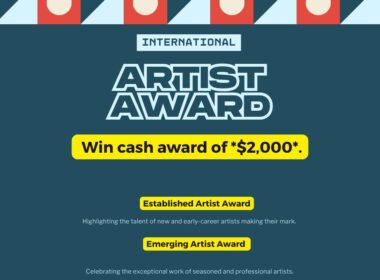







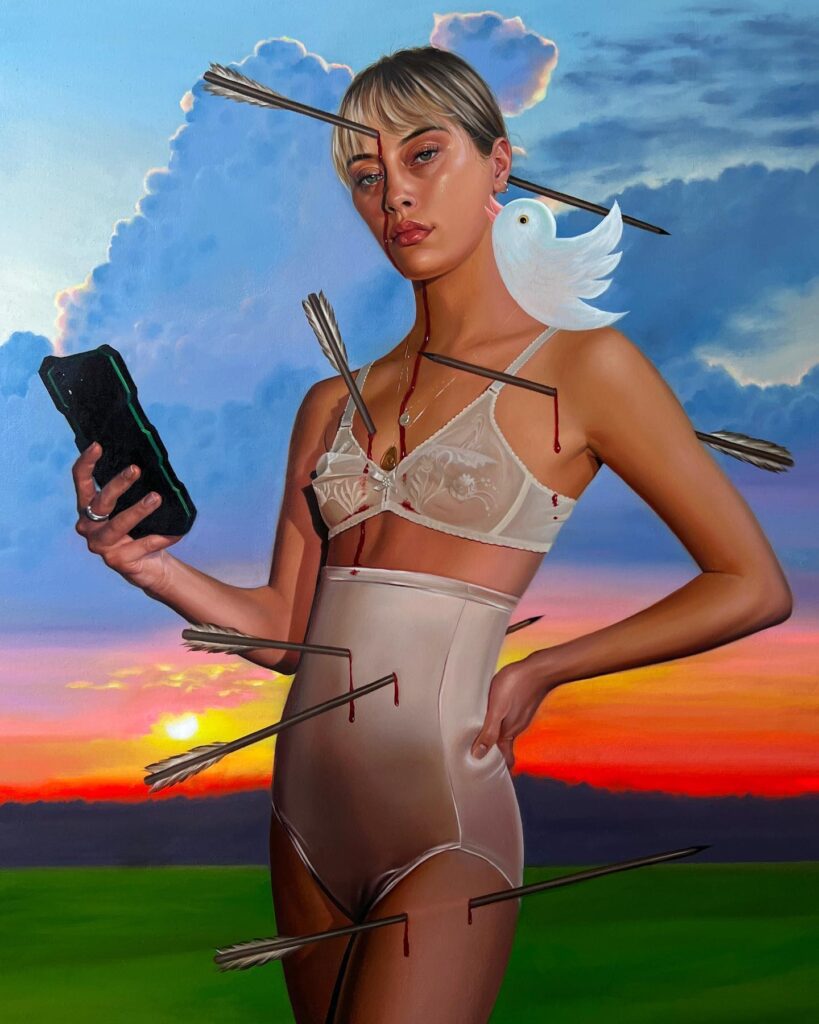

Comments 15